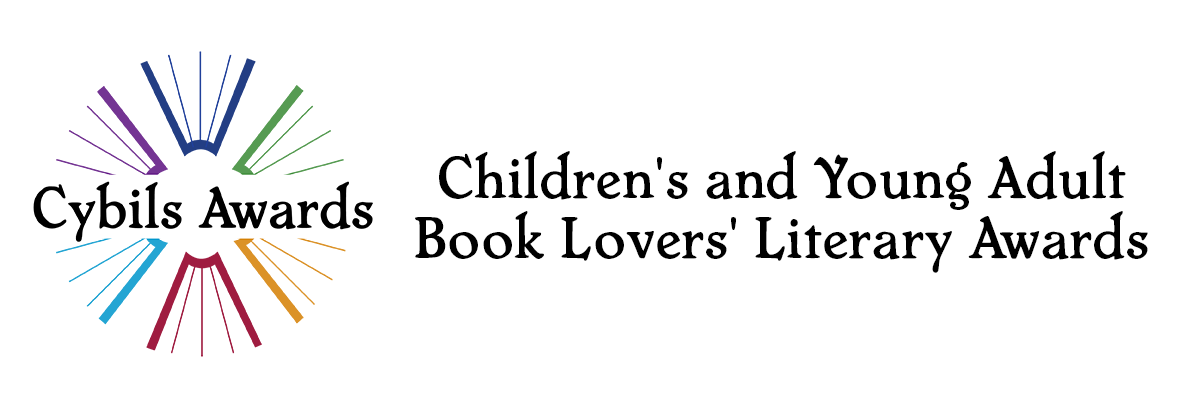Samuel Beckett said “Try again, fail again. Fail Better”. Not only did Swiss #2 tennis champ Stan Wawrinka have these words imprinted on his forearm, but this has become a mantra in education all over the country. Silicon Valley culture embraces the culture behind failing fast and it seems to be paying off. So with STEM (short for Science, Technology, Engineering and Math) becoming the core focus behind America’s curriculum, I dug into the Cybils database to find some hidden gems.
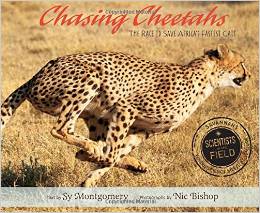 Chasing Cheetahs: The Race to Save Africa’s Fastest Cat by Sy Montgomery (2014 Elementary/Middle Grade Non-Fiction finalist) [Science] – Chasing Cheetahs is the latest in the series in the Scientists in the Field series authored by Sy Montgomery. This book reads well and reads fast. Deeply researched, the story behind Laurie Marker’s extra-ordinary out of the box thinking to save the cheetah from extinction, is not only fascinating but very enjoyable.
Chasing Cheetahs: The Race to Save Africa’s Fastest Cat by Sy Montgomery (2014 Elementary/Middle Grade Non-Fiction finalist) [Science] – Chasing Cheetahs is the latest in the series in the Scientists in the Field series authored by Sy Montgomery. This book reads well and reads fast. Deeply researched, the story behind Laurie Marker’s extra-ordinary out of the box thinking to save the cheetah from extinction, is not only fascinating but very enjoyable.
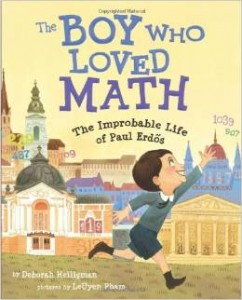 The Boy Who Loved Math: The Improbable Life of Paul Erdos by Deborah Heiligman (2013 Elementary/Middle Grade Non-Fiction finalist)[Math] – Want to inspire your young ones in Math? Then read The Boy Who Loved Math, a great picture book biography of one of the most famous mathematicians, Paul Erdos. What I loved about this gem of a book, was how the author Deborah Heiligman makes a very interesting life readable to a younger kids. Older kids will delight in a math concepts cleverly hidden in the illustrations of this book.
The Boy Who Loved Math: The Improbable Life of Paul Erdos by Deborah Heiligman (2013 Elementary/Middle Grade Non-Fiction finalist)[Math] – Want to inspire your young ones in Math? Then read The Boy Who Loved Math, a great picture book biography of one of the most famous mathematicians, Paul Erdos. What I loved about this gem of a book, was how the author Deborah Heiligman makes a very interesting life readable to a younger kids. Older kids will delight in a math concepts cleverly hidden in the illustrations of this book.
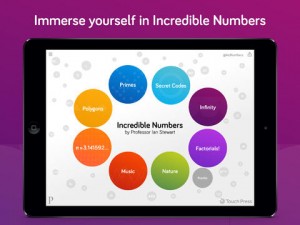 Incredible Numbers by Prof. Ian Stewart (2014 Book App Finalist)[Math] – Book apps are a great way to integrate technology and learning at the same time. “Incredible Numbers” is a fun interactive math app that makes concepts like infinity, pi and even secret codes fun!
Incredible Numbers by Prof. Ian Stewart (2014 Book App Finalist)[Math] – Book apps are a great way to integrate technology and learning at the same time. “Incredible Numbers” is a fun interactive math app that makes concepts like infinity, pi and even secret codes fun!
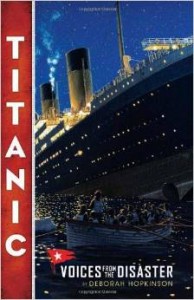 Titanic: Voices from the Disaster by Deborah Hopkinson (2012 YA Non-Fiction finalist)[Engineering] – Part of scientific thinking is asking the right questions. Deborah Hopkinson digs into the Titanic’s tragic collapse, takes a fresh new perspective and asks vital questions behind what could have been made right? What if the boat had slowed down? What if there were tighter safety standards? What if there were more lifeboats? Draw your own conclusions!
Titanic: Voices from the Disaster by Deborah Hopkinson (2012 YA Non-Fiction finalist)[Engineering] – Part of scientific thinking is asking the right questions. Deborah Hopkinson digs into the Titanic’s tragic collapse, takes a fresh new perspective and asks vital questions behind what could have been made right? What if the boat had slowed down? What if there were tighter safety standards? What if there were more lifeboats? Draw your own conclusions!
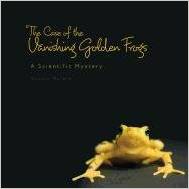 The Case of Vanishing Golden Frogs: A Scientific Mystery by Sandra Markle (2011 Elementary/Middle Grade Non-Fiction finalist)[Science] – Sandra Markle is behind the scientific mystery series. Subsequent to this title The Case of Vanishing Golden Frogs, she has written The Case of Vanishing Little Brown Bats and The Case of Vanishing Honeybees, both superbly researched and intriguingly written. I think this is a wonderful series to introduce non-fiction reading for kids. It reminded me of the adult non-fiction Pulitzer prize 2015 winner The Sixth Extinction. Important readings for everyone!
The Case of Vanishing Golden Frogs: A Scientific Mystery by Sandra Markle (2011 Elementary/Middle Grade Non-Fiction finalist)[Science] – Sandra Markle is behind the scientific mystery series. Subsequent to this title The Case of Vanishing Golden Frogs, she has written The Case of Vanishing Little Brown Bats and The Case of Vanishing Honeybees, both superbly researched and intriguingly written. I think this is a wonderful series to introduce non-fiction reading for kids. It reminded me of the adult non-fiction Pulitzer prize 2015 winner The Sixth Extinction. Important readings for everyone!
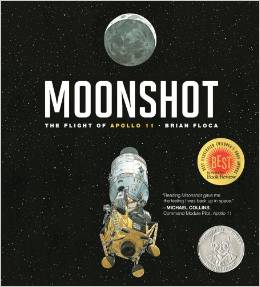 Moonshot: Flight of Apollo 11 by Brian Floca (2009 Elementary/Middle Grade Non-Fiction finalist)[Technology] – Apollo 11 was the first spaceflight to land humans on the Moon. Brian Floca’s depiction of this important scientific journey, is beautifully re-told in this picture book format. I would pair it with Meghan McCarthy’s Astronaut Handbook (2008 Elementary/Middle Grade Non-Fiction finalist [Technology]) and make this a perfect duo in the space science category.
Moonshot: Flight of Apollo 11 by Brian Floca (2009 Elementary/Middle Grade Non-Fiction finalist)[Technology] – Apollo 11 was the first spaceflight to land humans on the Moon. Brian Floca’s depiction of this important scientific journey, is beautifully re-told in this picture book format. I would pair it with Meghan McCarthy’s Astronaut Handbook (2008 Elementary/Middle Grade Non-Fiction finalist [Technology]) and make this a perfect duo in the space science category.
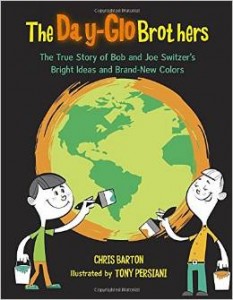 The Day-Glo Brothers by Chris Barton, illustrated by Tony Persiani (2009 Elementary/Middle Grade Non-Fiction Finalist)[Science] – Watch out! Reading this picture book might send your junior inventor running to the basement and testing out their own theories! This wonderful picture book biography of brothers Bob and Joe Switzer is an irresistible read. You will learn about how the two brothers invented the glow colors and at the same time made a huge contribution to the world around them.
The Day-Glo Brothers by Chris Barton, illustrated by Tony Persiani (2009 Elementary/Middle Grade Non-Fiction Finalist)[Science] – Watch out! Reading this picture book might send your junior inventor running to the basement and testing out their own theories! This wonderful picture book biography of brothers Bob and Joe Switzer is an irresistible read. You will learn about how the two brothers invented the glow colors and at the same time made a huge contribution to the world around them.
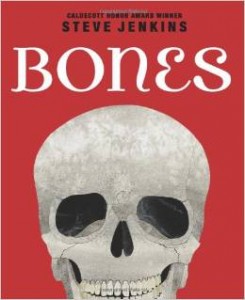 Bones: Skeletons and How They Work by Steve Jenkins (2010 Elementary/Middle Grade Non-Fiction finalist)[Science] – I have to make disclaimer here. I absolutely love all things Steve Jenkins. From his latest installment of Eye to Eye, The Beetle Book or Just a Second, Steve Jenkins takes a creative and artistic spin on children’s non-fiction. In Bones: Skeletons and How They Work, Jenkins introduces a wide range of bones from snakes, to humans to bats! This could easily become a favorite for curious young minds!
Bones: Skeletons and How They Work by Steve Jenkins (2010 Elementary/Middle Grade Non-Fiction finalist)[Science] – I have to make disclaimer here. I absolutely love all things Steve Jenkins. From his latest installment of Eye to Eye, The Beetle Book or Just a Second, Steve Jenkins takes a creative and artistic spin on children’s non-fiction. In Bones: Skeletons and How They Work, Jenkins introduces a wide range of bones from snakes, to humans to bats! This could easily become a favorite for curious young minds!
 Pop! The Invention of Bubble Gum by Meghan McCarthy (2010 Elementary/Middle Grade Non-Fiction finalist)[Science] – An instant kid appeal, Pop! The Invention of Bubble Gum is super fun and engaging read. I love to read stories about curious minds, and this is just such a story. Walter is an accountant at a candy company. Scientists there have been trying to develop a gum that would blow bubbles. So far they have had no luck! Enter Walter! Curiosity and the challenge gets to him and he decides to try his hand at it. Read this one to find out more.
Pop! The Invention of Bubble Gum by Meghan McCarthy (2010 Elementary/Middle Grade Non-Fiction finalist)[Science] – An instant kid appeal, Pop! The Invention of Bubble Gum is super fun and engaging read. I love to read stories about curious minds, and this is just such a story. Walter is an accountant at a candy company. Scientists there have been trying to develop a gum that would blow bubbles. So far they have had no luck! Enter Walter! Curiosity and the challenge gets to him and he decides to try his hand at it. Read this one to find out more.
 When Lunch Fights Back: Wickedly Clever Animal Defenses by Rebecca L. Johnson (2014 Elementary/Middle Grade Non-Fiction finalist)[Science] – When I read this picture book for a bunch of 7 year-olds, the young crowd was GLUED! Photographs of actual creatures timed to show their best defensive profiles will delight the readers. Gross facts about techniques that some of these animals use to survive on a daily basis are not just interesting but fascinating as well. I would highly recommend When Lunch Fights Back for readers of all ages and especially to reluctant readers.
When Lunch Fights Back: Wickedly Clever Animal Defenses by Rebecca L. Johnson (2014 Elementary/Middle Grade Non-Fiction finalist)[Science] – When I read this picture book for a bunch of 7 year-olds, the young crowd was GLUED! Photographs of actual creatures timed to show their best defensive profiles will delight the readers. Gross facts about techniques that some of these animals use to survive on a daily basis are not just interesting but fascinating as well. I would highly recommend When Lunch Fights Back for readers of all ages and especially to reluctant readers.
— Reshama Deshmukh, Stacking Books
